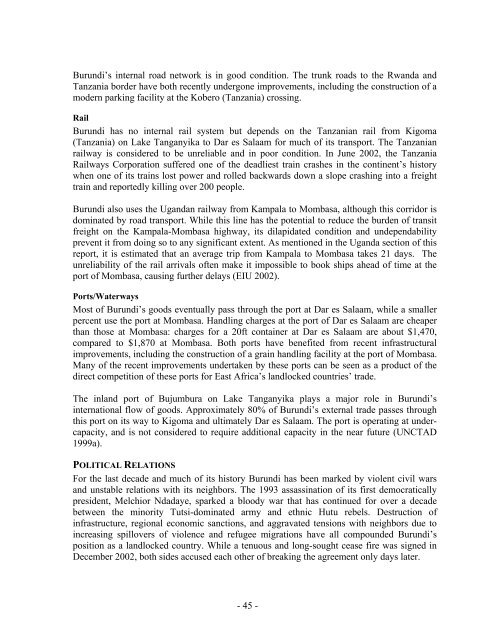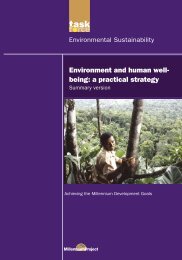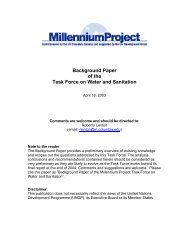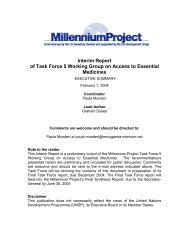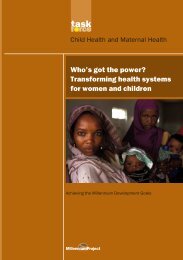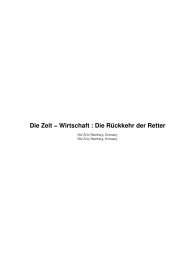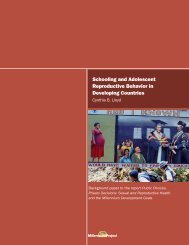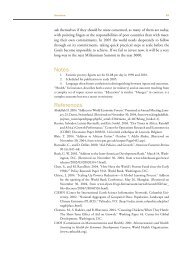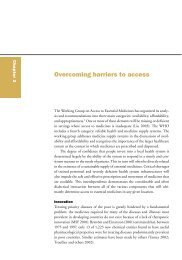the challenges facing landlocked developing countries: a case study ...
the challenges facing landlocked developing countries: a case study ...
the challenges facing landlocked developing countries: a case study ...
You also want an ePaper? Increase the reach of your titles
YUMPU automatically turns print PDFs into web optimized ePapers that Google loves.
Burundi’s internal road network is in good condition. The trunk roads to <strong>the</strong> Rwanda and<br />
Tanzania border have both recently undergone improvements, including <strong>the</strong> construction of a<br />
modern parking facility at <strong>the</strong> Kobero (Tanzania) crossing.<br />
Rail<br />
Burundi has no internal rail system but depends on <strong>the</strong> Tanzanian rail from Kigoma<br />
(Tanzania) on Lake Tanganyika to Dar es Salaam for much of its transport. The Tanzanian<br />
railway is considered to be unreliable and in poor condition. In June 2002, <strong>the</strong> Tanzania<br />
Railways Corporation suffered one of <strong>the</strong> deadliest train crashes in <strong>the</strong> continent’s history<br />
when one of its trains lost power and rolled backwards down a slope crashing into a freight<br />
train and reportedly killing over 200 people.<br />
Burundi also uses <strong>the</strong> Ugandan railway from Kampala to Mombasa, although this corridor is<br />
dominated by road transport. While this line has <strong>the</strong> potential to reduce <strong>the</strong> burden of transit<br />
freight on <strong>the</strong> Kampala-Mombasa highway, its dilapidated condition and undependability<br />
prevent it from doing so to any significant extent. As mentioned in <strong>the</strong> Uganda section of this<br />
report, it is estimated that an average trip from Kampala to Mombasa takes 21 days. The<br />
unreliability of <strong>the</strong> rail arrivals often make it impossible to book ships ahead of time at <strong>the</strong><br />
port of Mombasa, causing fur<strong>the</strong>r delays (EIU 2002).<br />
Ports/Waterways<br />
Most of Burundi’s goods eventually pass through <strong>the</strong> port at Dar es Salaam, while a smaller<br />
percent use <strong>the</strong> port at Mombasa. Handling charges at <strong>the</strong> port of Dar es Salaam are cheaper<br />
than those at Mombasa: charges for a 20ft container at Dar es Salaam are about $1,470,<br />
compared to $1,870 at Mombasa. Both ports have benefited from recent infrastructural<br />
improvements, including <strong>the</strong> construction of a grain handling facility at <strong>the</strong> port of Mombasa.<br />
Many of <strong>the</strong> recent improvements undertaken by <strong>the</strong>se ports can be seen as a product of <strong>the</strong><br />
direct competition of <strong>the</strong>se ports for East Africa’s <strong>landlocked</strong> <strong>countries</strong>’ trade.<br />
The inland port of Bujumbura on Lake Tanganyika plays a major role in Burundi’s<br />
international flow of goods. Approximately 80% of Burundi’s external trade passes through<br />
this port on its way to Kigoma and ultimately Dar es Salaam. The port is operating at undercapacity,<br />
and is not considered to require additional capacity in <strong>the</strong> near future (UNCTAD<br />
1999a).<br />
POLITICAL RELATIONS<br />
For <strong>the</strong> last decade and much of its history Burundi has been marked by violent civil wars<br />
and unstable relations with its neighbors. The 1993 assassination of its first democratically<br />
president, Melchior Ndadaye, sparked a bloody war that has continued for over a decade<br />
between <strong>the</strong> minority Tutsi-dominated army and ethnic Hutu rebels. Destruction of<br />
infrastructure, regional economic sanctions, and aggravated tensions with neighbors due to<br />
increasing spillovers of violence and refugee migrations have all compounded Burundi’s<br />
position as a <strong>landlocked</strong> country. While a tenuous and long-sought cease fire was signed in<br />
December 2002, both sides accused each o<strong>the</strong>r of breaking <strong>the</strong> agreement only days later.<br />
- 45 -


